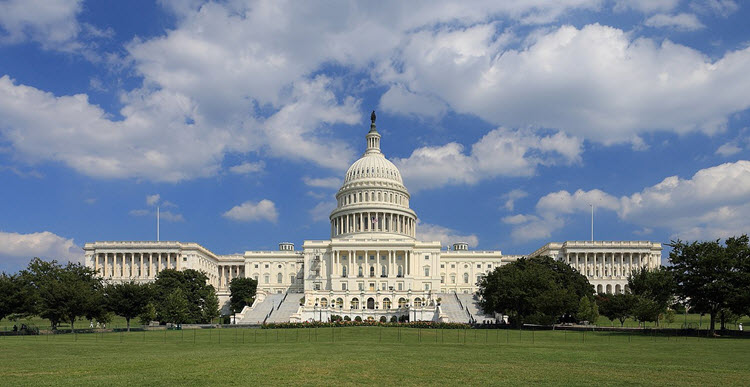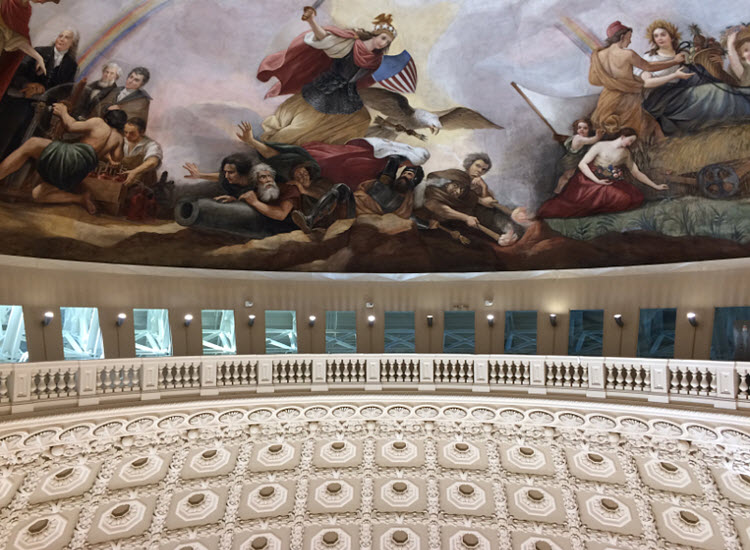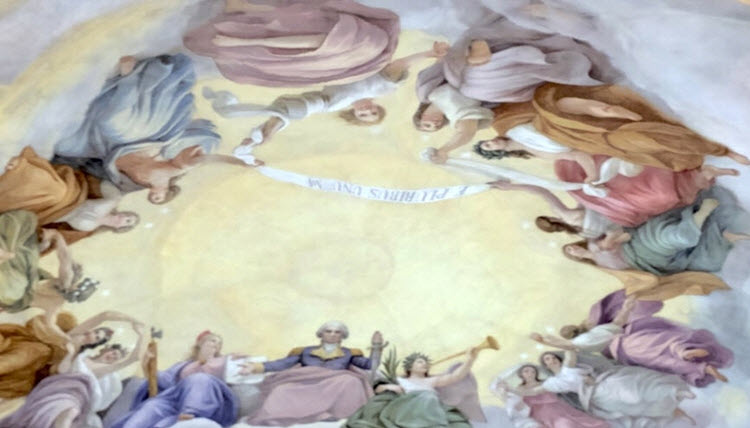E pluribus unum. The meaning of this Latin phrase: out of many, one. This is the traditional motto of the United States of America, initially suggested in 1776 and approved by an Act of Congress in 1782 for use on the Great National Seal. These words, signifying the unification of the 13 original colonies into a single nation, grace our coins, our dollar bills, and a number of state flags.

Like so many other Latin phrases — or mottos of any sort — we don’t pay much attention. After all, we’re busy with our everyday lives. In these days of the worsening pandemic, we’re busy just trying to survive.
Something I never knew before a few days ago: In addition to historical paintings that line the walls of the U.S. Capitol’s Rotunda — many of us have noticed them in the background on video or TV news — there is an enormous mural painted inside the dome of the U.S. Capitol. And at the center of that mural is a banner with these words: e pluribus unum. Out of many, one.
Now, I’ve never been inside the Capitol building. I’ve only seen its interiors streamed or broadcast on the news. But like millions of others across the world I’ve now seen the chaos and destruction that took place on January 6. Like millions of others across the world I watched scenes of insurrection play out — disbelieving, disgusted — yet somehow not shocked. Like millions of others across the world I find myself unsettled and anxious a few days later. This heightened state is the result of additional video that reveals the extent of the violence, the clear menace to the life of the vice-president and speaker of the house, and the number of indications that more violence may lie ahead.
And then I remembered this. Several years ago one of my sons was part of a small group tour that went up inside the Capitol dome. The images I’ve included here, with the exception of the exterior of the U.S. Capitol, are from that tour.
When my son initially shared these photographs with me I was amazed. I had assumed that the building would be beautiful and stately inside, but I had never thought about it in any specific way. I mean… why would I? And I had never imagined the elaborate design and structure that was the dome itself.

Certainly, I’ve marveled at historic buildings when I’ve been privileged enough to see them; Notre Dame in Paris comes to mind. And when Notre Dame burned a few years ago, then, too, I watched in horror, like millions of others. To see history, symbolism and beauty destroyed is painful. To see the attempts at its destruction at the hands of a mob, even more so.
So what about the Capitol, this “cathedral” of democracy that houses our Congress? Have I ever even given it a thought? Have you? For that matter, have I ever thoughtfully considered the meaning of “out of many, one”? Have you?
What about my knowledge of American history? Why are there so many holes and inaccuracies in the versions that I learned as a child? Am I doing enough to make up for those deficiencies, and consequently become a more informed, more open-minded, more responsible friend, neighbor, citizen? More importantly, what about our nation’s children, now? Is their education providing a more accurate and complete history? And what about our missing education in basic civics?
I wanted to see a selection of my son’s photos of the Capitol. When I looked, I was surprised by what was painted inside the dome, high overhead.

I turned to the History of the U.S. Capitol Building for more details, to this description of the Rotunda and its historical paintings, and to the the mural in the “eye” of the Rotunda painted by Constantino Brumidi in 1865.
In the central group of the fresco, Brumidi depicts George Washington rising to the heavens in glory, flanked by female figures representing Liberty and Victory/Fame and surrounded by six groups of figures. The fresco is suspended 180 feet above the Rotunda floor and covers an area of 4,664 square feet.
Here’s what I noticed in the center of the fresco. Do you see it? The banner? The words emblazoned on the banner?

As I mentioned above — e pluribus unum. Out of many, one.
I keep asking myself: Will we ever get there?
Note the year in which the fresco was executed. 1865. The fresco was “painted in 11 months at the end of the Civil War…”
That timing seems particularly fitting. But are we anywhere near the end of what some pundits call the “cold” civil war we’ve been living through? And what of this “apotheosis,” the use of a person to signify the elevation of an ideal? The notion that “out of many, one” is possible?
Other images have bubbled up in my memory this weekend. Scenes of flooding after Hurricane Harvey. Americans driving across the country to rescue strangers. No one asked about political affiliation, skin color, which god they worshipped if any. People helped. Heroically, generously. In a way we think of as typically American.
Also typically American is our history of hate. Hate that clearly remains part of our present.
As we stare into these final days of the Trump administration, as we realize that a second impeachment may be launched this week for “inciting an insurrection” — how stunning is that??? — it’s hard to imagine how we redirect this polarized nation toward an ideal of unity.
I welcome your thoughts.
Exterior image of the Capitol, West side, credit Martin Falbisoner via Wiki creative commons license share-alike 3.0. Other images, courtesy of my son.
You May Also Enjoy
Certainly for some, the only people whose votes count are white men. Every time there’s progress, the old guard is shocked and pushes back.
Beautiful photos.
Too true.